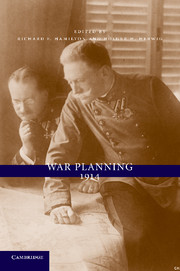Book contents
- Frontmatter
- Contents
- List of Maps
- Contributors
- Acknowledgments
- 1 War Planning: Obvious Needs, Not So Obvious Solutions
- 2 Austria-Hungary
- 3 German War Plans
- 4 War Planning and Initial Operations in the Russian Context
- 5 France
- 6 Great Britain
- 7 Italy
- 8 Conclusions
- Appendix: Suggested Reading
- Index
- References
4 - War Planning and Initial Operations in the Russian Context
Published online by Cambridge University Press: 27 January 2010
- Frontmatter
- Contents
- List of Maps
- Contributors
- Acknowledgments
- 1 War Planning: Obvious Needs, Not So Obvious Solutions
- 2 Austria-Hungary
- 3 German War Plans
- 4 War Planning and Initial Operations in the Russian Context
- 5 France
- 6 Great Britain
- 7 Italy
- 8 Conclusions
- Appendix: Suggested Reading
- Index
- References
Summary
Between 1873 and 1914, Russian preparation for a European war evolved through two stages. The first was very long and the second very brief, and there was a jagged transition between the two. Some knowledgeable observers termed these stages “systems,” because in varying degrees each period gave rise to an overarching scheme with a governing strategy that flowed from geopolitical circumstance, threat assessment, alliance commitments, course of action development, detailed planning, and resource allocation. For various reasons, neither period's system fully met requirements for engagement in a Great Power war. However, only the second, sometimes called the “Sukhomlinov System” after Russia's last pre-1914 war minister, would be put to the test. When war did come, this system's inadequacies and internal inconsistencies meant that Russia would enter hostilities as it had entered nearly all its past wars, like a chess player with poor opening moves. The result during the initial period of conflict was catastrophic failure against Germany and only partial success against Austria-Hungary.
Setting the Terms
These outcomes testified to anomalies and dysfunctions that lay below the surface of the apparent system. In Russia, prevailing notions of statecraft and monarchical prerogative often inhibited the effective linking of ends, ways, and means according to a mature understanding of higher, or grand, strategy. In institutional terms, modified autocratic politics defined politico-military jurisdictions and the limits of higher-level coordinating authority in ways that precluded optimal collaboration during strategy development, war planning, and resource allocation.
- Type
- Chapter
- Information
- War Planning 1914 , pp. 80 - 142Publisher: Cambridge University PressPrint publication year: 2009
References
- 1
- Cited by

